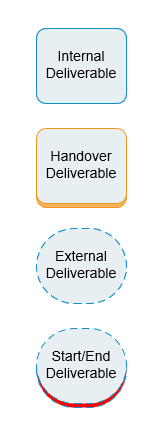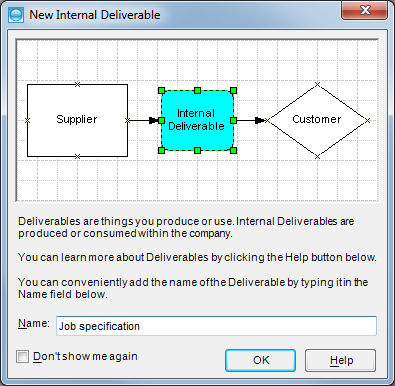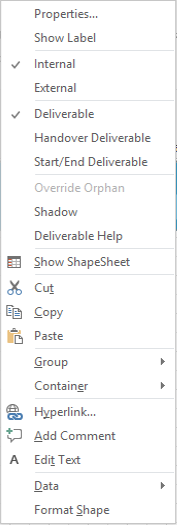Deliverables
 Process Navigator uses the Deliverable shape to represent the Inputs you use and the Outputs you produce.
Deliverables are so important to process mapping because they capture the essence of the process.
Process Navigator uses the Deliverable shape to represent the Inputs you use and the Outputs you produce.
Deliverables are so important to process mapping because they capture the essence of the process.
Once you get into the habit of viewing the things you do as a means to obtaining a Deliverable, you will find quite naturally that the usefulness of your work to your customers will improve. You will become more customer-focused because you will explicitly recognise your Deliverables as the service you provide to them.
External and Internal Deliverables
An external Deliverable is one that is used or produced outside the scope of your end-to-end process map. Typically, an external Input will come from the companyís suppliers and an external Output will go to the companyís customers. An external deliverable can also be described as an input or output which initiates or terminates a process.
An internal Deliverable is one that is used by another process within the scope of your end-to-end process map. It will have Off-Page Connectors associated with it to enable you traverse the process.
It is important to distinguish external from internal Deliverables for the following reasons:
- Your Customers are the most important part of your business. Your Customersí impression of your company is gained through the Deliverables they receive. Get that wrong and they will go elsewhere.
- Your Suppliers represent a potential point of weakness. Modern companies can only be as strong as their weakest supplier. These days, whole supply chains compete against each other, not just individual companies. Identifying external Inputs helps you to identify external dependencies and thereby manage external risk.
- You donít produce external Inputs, so you have little control over their quality other than to test and reject. Modern companies are helping their suppliers attain the quality standards they require and recognising external Inputs helps to do this.
Handover Deliverable
A Handover Deliverable is a type of Internal Deliverable and can be used to show where a deliverable moves between Departments or Functional Areas within the Organisation.
Start/End Deliverable
A Start/End Deliverable is a type of External Deliverable in that it indicates the end of a process. It is often used to designate an Archive.
To change the type of deliverable without re-dropping it
Right-click on the Deliverable and on the menu, you will have the option to select a different type of deliverable. To change from a Handover or Start/End Deliverable to an External deliverable, you have to select 'Deliverable' first.
Naming a Deliverable
A deliverable can be named as it is dropped, using the Tip Window:

or you can press F2 and add or edit the deliverable name.
Deliverable Right Click Menu
Right click on a Deliverable and the following will appear:

The top ten items are Process Navigator-specific; the rest are provided by Visio.
| Menu item | Description |
|---|---|
| Properties... | Provides access to the Deliverable Properties window. |
| Show Label | When ticked, a Label will show below the Deliverable. Click to turn the Label on or off. |
| Internal | When ticked, indicates that the shape is an Internal Deliverable. Click if you want to change the shape to an Internal Deliverable. |
| External | When ticked, indicates that the shape is an External Deliverable. Click if you want to change the shape to an External Deliverable. |
| Deliverable | When ticked, indicates that the shape is an Internal or External Deliverable (i.e. not a Handover or Start/End Deliverable). Click if you want to change from a Handover or Start/End Deliverable to an Internal Deliverable. |
| Handover Deliverable | When ticked, indicates that the shape is a Handover Deliverable. Click if you want to change to a Handover Deliverable. |
| Start/End Deliverable | When ticked, indicates that the shape is a Start/End Deliverable. Click if you want to change to a Start/End Deliverable. |
| Override Orphan | This is only available when the Deliverable is an Orphan and allows the red colour to be overridden. See Orphans which describes what they are and how to deal with them. |
| Shadow | When ticked, it indicates the shape has a shadow. Click to change to/from a shadow |
| Deliverable Help | Provides context-sensitive help on the Deliverable. |